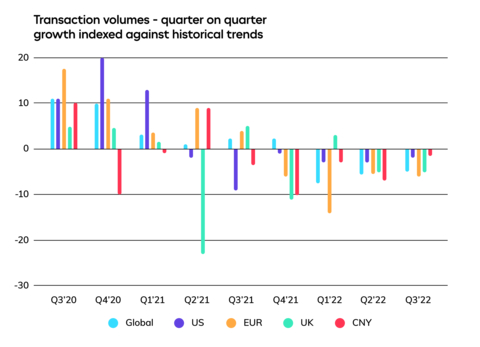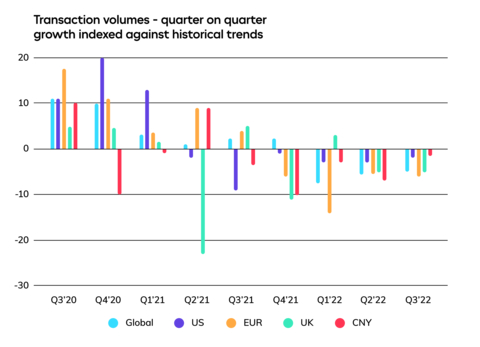SAN FRANCISCO--(BUSINESS WIRE)--Data from Tradeshift, the global network for digital trade, reveals that trade activity across retail, manufacturing and transport & logistics dropped sharply in Q3, as the volume of transactions between buyers and suppliers globally slowed for the third consecutive quarter.
According to Tradeshift’s Index of Global Trade Health, global supply chain activity fell by a further 5 points in Q3 compared to the baseline. New orders, in particular, are drying up at an accelerated rate as inflation-driven costs and global uncertainty mount. Global order volumes dropped a further 7 points below expected levels in Q3 following a 6-point drop in the previous quarter, the most significant six-month fall since the height of the pandemic.
Manufacturing dropped 11 points below the expected range in Q3. Retail supply chain activity was 9 points below the baseline, the slowest growth in 18 months. Waning demand in these sectors is also leading to lower demand in the transport and logistics sector. Activity across the sector was 8 points lower than expected in Q3, the second consecutive quarter of declining growth.
“The good news is that supply chain bottlenecks are easing, and shipping costs are falling,” said Christian Lanng, CEO of Tradeshift. “The bad news is that this is largely a result of waning demand, and that trend now appears to be accelerating. This is particularly hard for smaller suppliers who have simply swapped pressure in one direction for an equally treacherous kind of pressure in the other direction. If suppliers get into financial difficulty and start to fold, we could start to see a repeat of the problems supply chains faced during the pandemic.”
Tradeshift’s analysis places Europe at the epicentre of the latest slowdown. Supply chain activity across the Eurozone fell by a further 6 points in Q3 as the energy crisis triggered by Russia’s invasion of Ukraine wiped out consumer spending and placed significant cost pressures on supply chains. In the UK, which faces a similar range of challenges, trade activity fell by a further 5 points in Q3.
A different picture is, however, emerging in the US. Momentum is slowing but at a much gentler rate than elsewhere in the world. Total transaction volumes tracked at just 2 points below the expected level in Q3. In China, local supply chain activity also grew at a relatively healthy rate in Q3, just 1 point below the expected range. However, activity levels across China’s supply chains have been very erratic since the beginning of the year, and this is unlikely to change as long as the lockdown policy remains in force.
“Supply chains in the US seem to have stabilised,” said Lanng. “As long as consumers keep spending, they may even start to see an upside from lower operating costs. Europe faces a much harder road ahead. The energy crisis comes down to a failure to maintain the balance between access, sustainability and security of supply. As organisations take a hard look at the resilience of their supply chains, maintaining this balance should be front of mind.”
About Tradeshift’s Index of Global Trade Health
Tradeshift’s Index of Global Trade Health analyses business-to-business transaction volumes (orders processed from buyers and invoices processed from suppliers) submitted via the Tradeshift platform to offer a perspective of how external events may be impacting business-to-business commerce in a variety of different regions and sectors across the globe.
About Tradeshift
Tradeshift is the cloud-based supply chain platform that transforms the way B2B buyers and sellers connect, transact and trade. We’re a leader in e-invoicing and AP automation, offering full international compliance in 50+ countries, including China. We’re also an innovator in B2B marketplaces and embedded fintech services that bring value, opportunity and growth to any business that joins the network. Headquartered in San Francisco, Tradeshift’s vision is to connect every company in the world, creating economic opportunity for all. Today, the Tradeshift platform is home to a rapidly growing community of buyers and sellers operating in more than 190 countries. Find out more at: www.Tradeshift.com
Forward-looking statements
Any statements contained in this document that are not historical facts are forward-looking statements as defined in the U.S. Private Securities Litigation Reform Act of 1995. Tradeshift undertakes no obligation to publicly update or revise any forward-looking statements. All forward-looking statements are subject to various risks and uncertainties that could cause actual results to differ materially from expectations.
© 2022 Tradeshift Holdings Inc. All rights reserved.




